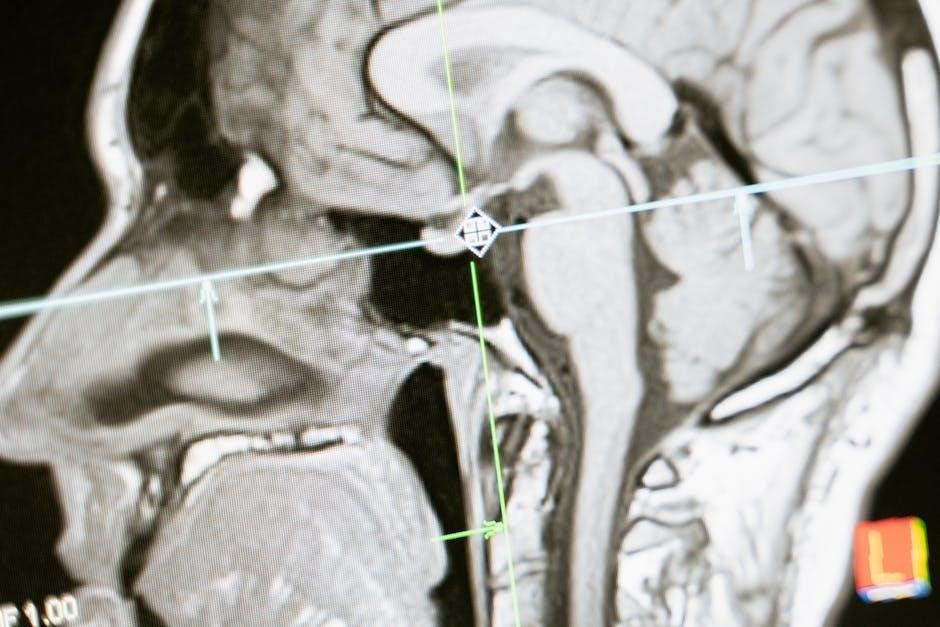Overview of Cortisol and Its Role in the Body
Cortisol is a steroid hormone produced by the adrenal gland, playing a crucial role in stress response, metabolism, and maintaining homeostasis․ It regulates blood sugar levels, aids in fat, protein, and carbohydrate metabolism, and supports immune function․ Cortisol levels naturally fluctuate throughout the day, typically peaking in the morning and decreasing at night․ This hormone is essential for responding to stress, suppressing inflammation, and helping the body recover from illness or injury․ Proper cortisol balance is vital for overall health and well-being․
1․1 What is Cortisol?
Cortisol is a vital steroid hormone produced by the adrenal glands․ Often referred to as the “stress hormone,” it plays a central role in regulating metabolism, immune response, and helping the body adapt to stress․ Cortisol levels naturally fluctuate throughout the day, typically peaking in the morning and dropping at night․ It is essential for maintaining energy balance, reducing inflammation, and supporting overall bodily functions․ Imbalances in cortisol levels can significantly impact health, making accurate measurement, such as through saliva testing, crucial for diagnosis and treatment․
1․2 The Importance of Cortisol in Stress Response
Cortisol is often referred to as the “stress hormone” because of its critical role in the body’s response to stress․ It helps regulate blood sugar levels, suppress inflammation, and support immune function during stressful events․ Cortisol also aids in maintaining energy balance by promoting the metabolism of fat, protein, and carbohydrates․ This hormone ensures the body adapts effectively to both physical and emotional stress, making it indispensable for overall health and resilience․ Proper cortisol levels are essential for recovery and maintaining homeostasis after stress․
1․3 Cortisol Levels Throughout the Day
Cortisol levels naturally fluctuate throughout the day, following a circadian rhythm․ They typically peak in the early morning, around 8 AM, and gradually decline by evening․ This pattern helps regulate energy, metabolism, and bodily functions․ Proper cortisol balance ensures physical and mental well-being․ Abnormal variations in this rhythm may indicate health issues, such as Cushing’s syndrome or adrenal insufficiency․ Understanding these fluctuations is crucial for interpreting cortisol saliva test results, as timing impacts accuracy․

What is a Cortisol Saliva Test?
A cortisol saliva test is a non-invasive diagnostic tool to measure cortisol levels in saliva, helping assess adrenal function and hormonal balance․ Quest Diagnostics offers convenient testing options for accurate results․
2․1 Definition and Purpose of the Test
A cortisol saliva test is a non-invasive method to measure cortisol levels using a saliva sample․ It is primarily used to assess adrenal gland function, diagnose hormonal imbalances, and monitor conditions like Cushing’s syndrome or adrenal insufficiency․ The test is convenient, avoiding the need for blood draws, and provides accurate results․ It is often recommended for individuals experiencing symptoms of cortisol dysfunction, such as fatigue, weight changes, or mood disturbances․ Quest Diagnostics offers this test as part of their comprehensive diagnostic services․
2․2 Why Saliva Testing is Preferred
Saliva testing for cortisol is preferred due to its non-invasive and stress-free nature, making it ideal for patients․ It allows for multiple samples to be collected at different times, enabling serial testing to monitor cortisol levels throughout the day․ Unlike blood tests, saliva collection is pain-free and can be done at home, reducing anxiety and discomfort․ Additionally, saliva cortisol levels correlate well with free cortisol in the blood, providing accurate results․ Quest Diagnostics offers this convenient option, making it accessible for individuals to assess adrenal function and hormonal balance effectively․
2․3 Key Differences from Blood or Urine Tests
Saliva testing differs from blood or urine tests in terms of convenience and stress response․ Blood tests measure both bound and free cortisol, while saliva tests specifically measure free cortisol, reflecting the active form in the body․ Urine tests require a 24-hour collection, which is less practical․ Saliva testing is non-invasive, pain-free, and can be done at home, reducing stress that might alter results․ It also allows for multiple samples to be taken throughout the day, making it ideal for monitoring cortisol patterns․ This method is particularly useful for diagnosing conditions like Cushing’s syndrome․

Why Choose Quest Diagnostics for Cortisol Testing?
Quest Diagnostics offers convenient, accurate, and reliable cortisol testing with expertise in hormone analysis; Their services provide easy access, fast results, and trusted medical guidance․
3․1 Overview of Quest Diagnostics
Quest Diagnostics is a leading provider of diagnostic testing services, offering a wide range of medical tests, including hormone analysis like cortisol․ With a strong network of labs and patient service centers, Quest provides convenient access to testing․ Their advanced technology ensures accurate and reliable results, supported by expert medical professionals․ Quest’s services are designed to meet the needs of both healthcare providers and patients, offering a seamless experience from test selection to result interpretation․ Their commitment to quality and innovation makes them a trusted choice for cortisol testing․
3․2 Convenience of Quest’s Cortisol Testing
Quest Diagnostics offers unparalleled convenience for cortisol testing, allowing patients to purchase tests online without a doctor’s visit․ With numerous locations nationwide, sample collection is easily accessible․ Quest also provides home test kits, enabling individuals to collect saliva samples in the comfort of their own homes․ This flexibility reduces the need for multiple trips to a lab, making the process hassle-free․ Additionally, Quest’s online platform allows for scheduling and tracking tests, ensuring a seamless experience․ This user-friendly approach makes cortisol testing more accessible and efficient for everyone․
3․3 Accuracy and Reliability of Quest’s Test Results
Quest Diagnostics ensures high accuracy and reliability in cortisol testing through advanced technology and rigorous quality control․ Their saliva cortisol tests utilize proven methods, including LC/MS, to deliver precise results․ Quest’s expertise in hormone testing guarantees reliable data, essential for diagnosing conditions like Cushing’s syndrome․ With consistent accuracy, Quest’s test results are trusted by healthcare providers nationwide․ Their commitment to excellence ensures patients receive dependable information for informed medical decisions․

Preparing for the Cortisol Saliva Test
Ensure accurate results by following preparatory steps: rinse mouth with water 10 minutes prior, avoid food and fluids for 60 minutes, and refrain from steroid creams․
4․1 General Preparatory Instructions
To ensure accurate results, prepare for the cortisol saliva test by following these steps: rinse your mouth with water 10 minutes before collection․ Avoid eating, drinking, or brushing your teeth for at least 60 minutes prior․ Refrain from using steroid creams or medications containing cortisol for 24 hours․ Collect saliva at the prescribed times, such as 60 minutes after waking or before bedtime․ Avoid chewing gum or smoking․ Place the swab in your cheek or under your tongue for 2 minutes to absorb saliva․ Ensure the swab is fully saturated for sufficient volume․ Store samples properly and ship promptly to avoid delays․
4․2 Avoiding Food, Fluids, and Medications Before Testing
Do not eat, drink, or brush your teeth for at least 60 minutes before collecting saliva․ Avoid smoking or chewing gum․ Refrain from taking medications containing steroids or cortisol for 24 hours prior to testing․ These precautions prevent contamination and ensure accurate results․ Consult your healthcare provider about temporarily stopping any medications that might interfere with cortisol levels․ Proper adherence to these guidelines is crucial for reliable test outcomes․
4․3 Timing of Saliva Collection
Saliva collection is typically recommended at specific times to accurately measure cortisol levels․ For late-night cortisol testing, collect the sample around 11 PM, as this helps assess evening cortisol levels․ Ensure consistency in timing to avoid fluctuations; Rinse your mouth with water 10 minutes before collection to remove any debris․ Avoid eating, drinking, or brushing teeth for at least 60 minutes prior․ Follow your healthcare provider’s instructions for timing, as it may vary based on individual needs or suspected conditions․ Proper timing ensures reliable and accurate test results․

Collecting the Saliva Sample
Place the swab in your cheek or under the tongue for 2 minutes to absorb saliva․ Avoid chewing or moving the swab during collection․ Ensure the swab is fully saturated for accurate testing․
5․1 When to Collect the Sample
Saliva collection is typically recommended in the late evening, around 11 PM, to assess cortisol levels accurately․ This timing helps in screening for conditions like Cushing’s syndrome․ For general testing, collect the sample at least 60 minutes after eating, drinking, or taking medication to avoid contamination․ Always follow your healthcare provider’s specific instructions regarding the timing of saliva collection to ensure reliable test results․
5․2 Step-by-Step Collection Process
Rinse your mouth with water 10 minutes before collection․ Open the collection device and place the swab in your cheek or under your tongue․ Allow it to absorb saliva for 2 minutes without chewing․ Ensure the swab is fully saturated for accurate results․ Once done, place the swab in the provided tube, close it securely, and store it according to the instructions․ Avoid eating, drinking, or brushing teeth before collecting the sample to ensure accurate cortisol levels․
5․3 Ensuring Sufficient Saliva Volume
To ensure a sufficient saliva volume, rinse your mouth with water 10 minutes before collection․ Place the swab in your cheek or under your tongue and let it absorb saliva for 2 minutes․ Avoid chewing or moving the swab to prevent damage․ Once saturated, remove the swab and place it in the collection tube․ If the swab is not fully saturated, allow more time or repeat the process․ Proper saturation is critical for accurate test results․ Handle the sample carefully to avoid contamination or spillage․

Handling and Storing the Sample
Store the saliva sample upright in a cool, dry place․ If not shipped immediately, refrigerate at 2-8°C․ Avoid contamination and handle with care to ensure accuracy․
6․1 Proper Storage Conditions
The saliva sample should be stored upright in a cool, dry place to prevent contamination․ If the sample cannot be shipped immediately, it should be refrigerated at 2-8°C․ Avoid exposure to direct sunlight or heat sources, as this may degrade the cortisol levels․ Proper storage ensures the integrity of the sample for accurate test results․ Always follow Quest Diagnostics’ specific instructions for handling and storing the saliva collection device to maintain sample viability․
6․2 Shipping Instructions for the Sample
Ship the saliva sample to Quest Diagnostics via overnight courier to ensure timely processing․ Place the sealed sample container in a protective envelope or box with ice packs if refrigerated․ Include the completed test requisition form to avoid delays․ Ensure the swab is securely packaged to prevent leakage or damage during transit․ Follow Quest’s specific shipping guidelines to guarantee sample integrity and prompt analysis․ Proper packaging and expedited shipping are crucial for accurate cortisol test results․

The Testing Process at Quest Diagnostics
Quest Diagnostics processes saliva samples using advanced technology like LC/MS to measure cortisol levels accurately․ They ensure reliable results by following strict protocols and quality standards․
7;1 How Quest Processes Saliva Samples
Quest Diagnostics processes saliva samples using advanced technology to ensure accurate cortisol measurement․ Upon receiving the sample, it is analyzed in state-of-the-art laboratories․ The saliva is tested for cortisol levels using methods like liquid chromatography-tandem mass spectrometry (LC/MS), which provides precise results․ Experienced technicians handle the samples, ensuring quality control and adherence to strict protocols․ The process involves preparing the saliva for testing, running the analysis, and interpreting the data to deliver reliable results․ This ensures patients receive accurate information about their cortisol levels for proper diagnosis and treatment․
7․2 Technology Used for Cortisol Measurement
Quest Diagnostics employs advanced technologies like liquid chromatography-tandem mass spectrometry (LC/MS) for precise cortisol measurement․ This method ensures high sensitivity and accuracy, distinguishing cortisol from other steroids․ The technology enables reliable detection of cortisol levels in saliva, even at low concentrations․ Quest also uses specialized assays and quality control measures to maintain consistency and precision․ This cutting-edge approach ensures accurate and reproducible results, making it a trusted choice for cortisol testing․ The technology supports early detection of hormonal imbalances, aiding in timely medical interventions․

Understanding Your Test Results
Quest Diagnostics provides clear cortisol test results, categorized as normal, elevated, or low․ Results are compared to established reference ranges, considering timing and individual factors․ Accurate interpretation by healthcare providers ensures proper diagnosis and treatment plans, addressing hormonal imbalances effectively․
8․1 Interpreting Cortisol Levels
Interpreting cortisol levels involves comparing test results to established reference ranges, which vary by timing and individual factors․ Late-night saliva cortisol levels are often used to screen for conditions like Cushing’s syndrome․ Elevated levels may indicate stress, Cushing’s, or adrenal issues, while low levels could suggest adrenal insufficiency․ Healthcare providers consider symptoms, test timing, and individual health history when interpreting results․ Accurate interpretation ensures proper diagnosis and guides treatment decisions, helping to restore hormonal balance and address underlying conditions effectively․
8․2 Factors That May Affect Test Results
Several factors can influence cortisol saliva test results, including food intake, medications, stress levels, and timing of sample collection․ Eating or drinking before testing can elevate cortisol levels, while certain medications like steroids may suppress them․ Stressful events or recent illnesses can also impact results․ Proper collection techniques, such as avoiding contamination and ensuring sufficient saliva volume, are crucial for accuracy․ Timing, especially late-night collections, must align with medical guidelines to reflect baseline levels accurately․ Adherence to preparatory instructions is essential to avoid skewed outcomes and ensure reliable results․
8․3 Follow-Up Steps Based on Results
Based on cortisol saliva test results, consult your healthcare provider to discuss implications and next steps․ If levels are abnormal, additional testing, such as blood or urine tests, may be recommended․ Lifestyle changes, like stress management or improved sleep, might be suggested to regulate cortisol levels; In cases of hormonal imbalances, referrals to an endocrinologist or further medical evaluation could be necessary․ Regular monitoring may be advised to track changes over time and ensure proper adrenal function․ Follow-up care is tailored to individual needs to restore balance and improve health outcomes․

Advantages of the Cortisol Saliva Test
The cortisol saliva test is non-invasive, convenient, and cost-effective․ It allows for serial testing, making it ideal for monitoring cortisol levels over time without discomfort or hassle․
9․1 Non-Invasive Nature of the Test
The cortisol saliva test is a non-invasive procedure that involves collecting a saliva sample using a swab, eliminating the need for blood draws or injections․ This method is pain-free and stress-free, making it suitable for all patients, including children and those with needle phobias․ The simplicity of saliva collection ensures a comfortable experience, reducing anxiety and discomfort often associated with blood tests․ Additionally, the non-invasive nature allows for easy serial testing, enabling healthcare providers to monitor cortisol levels over time without causing patient distress․ This approach promotes better compliance and accurate results․
9․2 Convenience for Serial Testing
Quest Diagnostics’ cortisol saliva test offers exceptional convenience for serial testing, allowing multiple samples to be collected effortlessly over time․ Patients can collect saliva at home using a simple swab, eliminating the need for repeated blood draws or lab visits․ This non-invasive method reduces discomfort and stress, making it ideal for monitoring cortisol levels during stressful events or for diagnosing conditions like Cushing’s syndrome․ The ability to collect samples at specific times, such as late-night, enhances accuracy and ensures comprehensive results without disrupting daily routines․
9․4 Cost-Effectiveness
Quest Diagnostics’ cortisol saliva test is a cost-effective alternative to traditional blood or urine tests․ Its non-invasive nature reduces the need for medical professionals, lowering overall expenses․ Patients can collect samples at home, eliminating lab visit costs; Quest offers competitive pricing, making it accessible for regular monitoring․ The simplicity of the test kit and process further minimizes expenses, ensuring affordable and accurate cortisol level assessment without compromising quality․ This makes it a practical choice for both initial testing and ongoing health management․

Common Mistakes to Avoid
Common mistakes include improper saliva collection, ignoring preparatory instructions, and delayed sample shipping․ These errors can compromise test accuracy and validity, requiring retesting․ Proper protocols must be followed to ensure reliable results and avoid unnecessary delays or costs․ Attention to detail is crucial for accurate cortisol level measurement and interpretation․
10․1 Improper Collection Techniques
Improper collection techniques include not following the 60-minute fasting rule before saliva collection, which can contaminate the sample․ Chewing or moving the swab excessively during collection reduces saliva absorption․ Forgetting to saturate the swab fully leads to insufficient sample volume, a common reason for rejected tests․ Additionally, not adhering to the required collection time, such as late-night sampling, can result in inaccurate cortisol level measurements․ Proper technique ensures reliable results, avoiding the need for retesting and delays in diagnosis․
10․2 Ignoring Preparatory Instructions
Ignoring preparatory instructions can lead to inaccurate cortisol saliva test results․ Failing to avoid food, fluids, or medications before collection can contaminate the sample․ Not adhering to the 60-minute fasting rule or improper swab placement can cause insufficient saliva absorption․ Additionally, not rinsing the mouth with water 10 minutes prior can introduce contaminants․ For instance, consuming caffeine or brushing teeth too close to testing can also skew results․ Such oversights may require retesting, delaying diagnosis and treatment․
10․3 Delayed Shipping of Samples
Delayed shipping of saliva samples can compromise test accuracy, as cortisol levels may degrade if not stored properly․ Quest Diagnostics recommends refrigerating samples if not shipped immediately․ Delayed transit can lead to unreliable results, requiring retesting․ To avoid this, ensure samples are shipped promptly, ideally within 24 hours, using overnight shipping․ Proper packaging and adherence to storage instructions are critical to maintaining sample integrity․ Timely shipping ensures accurate cortisol measurement and reliable test outcomes․ Always follow Quest’s shipping guidelines to prevent delays and ensure optimal results․ Proper handling is essential for precise cortisol level assessment․
11․1 Summary of the Cortisol Saliva Test Process
The cortisol saliva test process involves collecting saliva samples at specified times, such as morning and late-night, using Quest’s specialized kits․ Proper preparation includes avoiding food, fluids, and medications for at least 60 minutes before collection․ The swab is placed in the mouth to absorb saliva for 2 minutes․ Samples are stored at room temperature or refrigerated if needed and shipped promptly․ Adhering to these steps ensures accurate results, making the process efficient and reliable for assessing cortisol levels․
11․2 Importance of Following Quest’s Instructions
Following Quest’s instructions for cortisol saliva testing ensures accurate and reliable results․ Proper sample collection, storage, and shipping procedures are critical to avoid contamination or degradation․ Ignoring guidelines, such as timing or preparation, can lead to inaccurate cortisol levels or test delays․ Adhering to Quest’s protocols maximizes the validity of your results, providing a clear understanding of your cortisol levels and enabling effective follow-up care․ Compliance with instructions is essential for obtaining meaningful and actionable health insights․
11․3 Benefits of Regular Cortisol Monitoring
Regular cortisol monitoring helps identify hormonal imbalances early, enabling timely interventions․ It aids in managing chronic conditions like Cushing’s syndrome or adrenal insufficiency․ Monitoring also tracks stress responses and recovery, supporting overall health․ Quest’s convenient saliva tests make frequent testing easy and non-invasive, promoting better health outcomes and personalized care․ Consistent monitoring ensures sustained wellness and allows healthcare providers to adjust treatments effectively, improving long-term health management․
